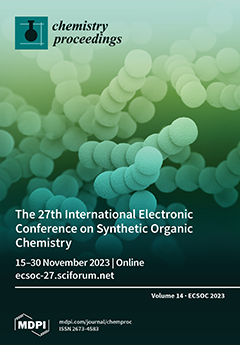A biologically effective study regarding the synthesis of a library of hybrids based on a triazole ring, propanamide and azinane was performed in this study. The targeted hybrids,
9a–9l, were synthesized through a multistep protocol followed by two methodologies, that is, conventional
[...] Read more.
A biologically effective study regarding the synthesis of a library of hybrids based on a triazole ring, propanamide and azinane was performed in this study. The targeted hybrids,
9a–9l, were synthesized through a multistep protocol followed by two methodologies, that is, conventional and microwave-assisted ones. Initially, compound
3 was synthesized via the room-temperature stirring of 4-methoxybenzenesulfonyl chloride (
1) and ethyl ester (
2). Resulting carboxylate was converted into carbohydrazide
4, which was refluxed with phenyl isothiocyanate and KOH to synthesize product
5. A library of amides,
8a–8l, was stirred at room temperature with compound
5 to avail the targeted library of hybrids
9a–9l. The designed hybrids were screened for their antioxidant, urease, AChE and BChE inhibition potential. All the compounds were found to be active with variable potential. The best antioxidant agent was compound
9c with an IC
50 value of 45.2 ± 0.15. The compound
9e (63.27 ± 1.21) was the best AChE inhibitor;
9g (20.2 ± 0.21) and
9k (19.2 ± 0.09) were the best anti-urease agents; and
9d (15.5 ± 0.39) and
9e (15.9 ± 0.67) were the best BChE inhibitors. The computational and BSA binding studies of the selected synthesized compounds against urease, BChE and AChE enzymes were carried out to elaborate the strong and weak enzyme-inhibition potential through the binding forces of the synthesized compounds with the different enzymatic sites that are responsible for their activity.
Full article



